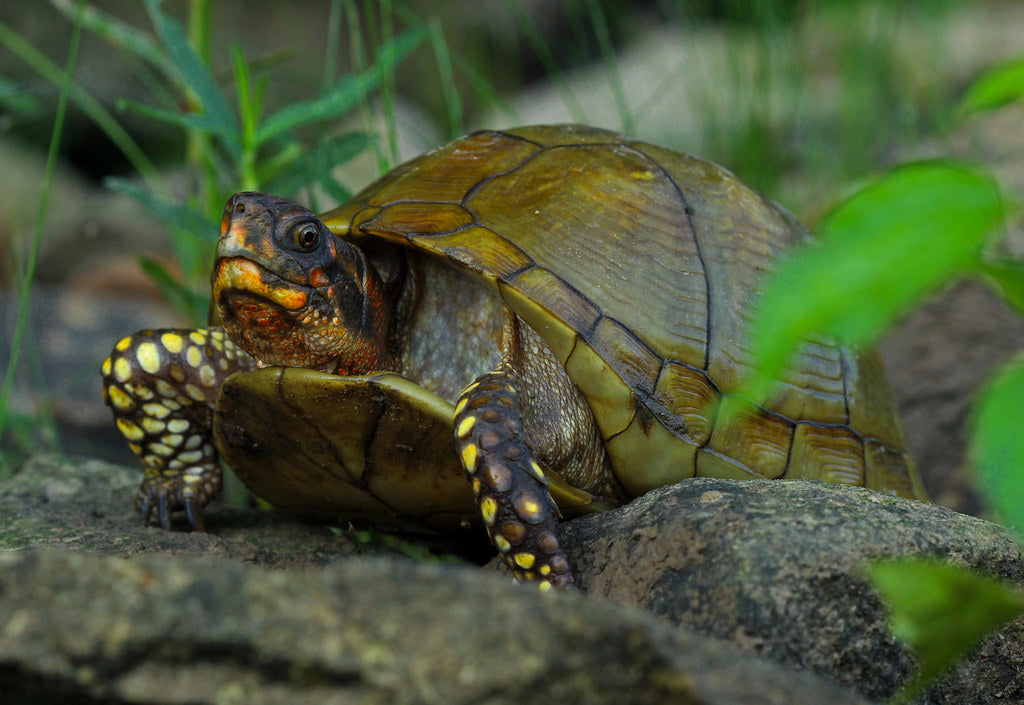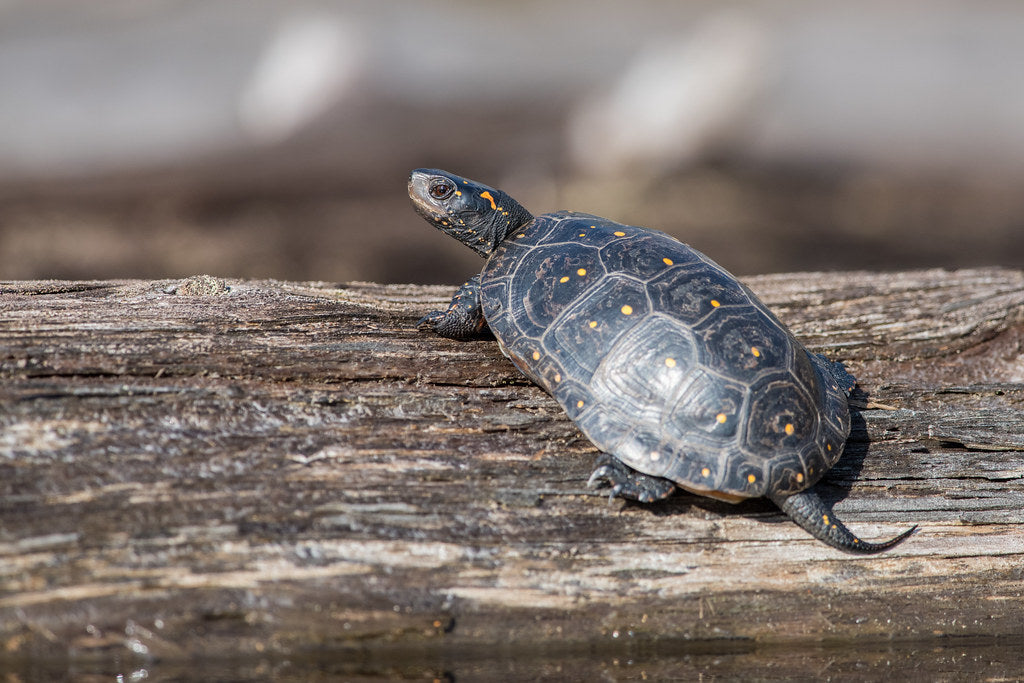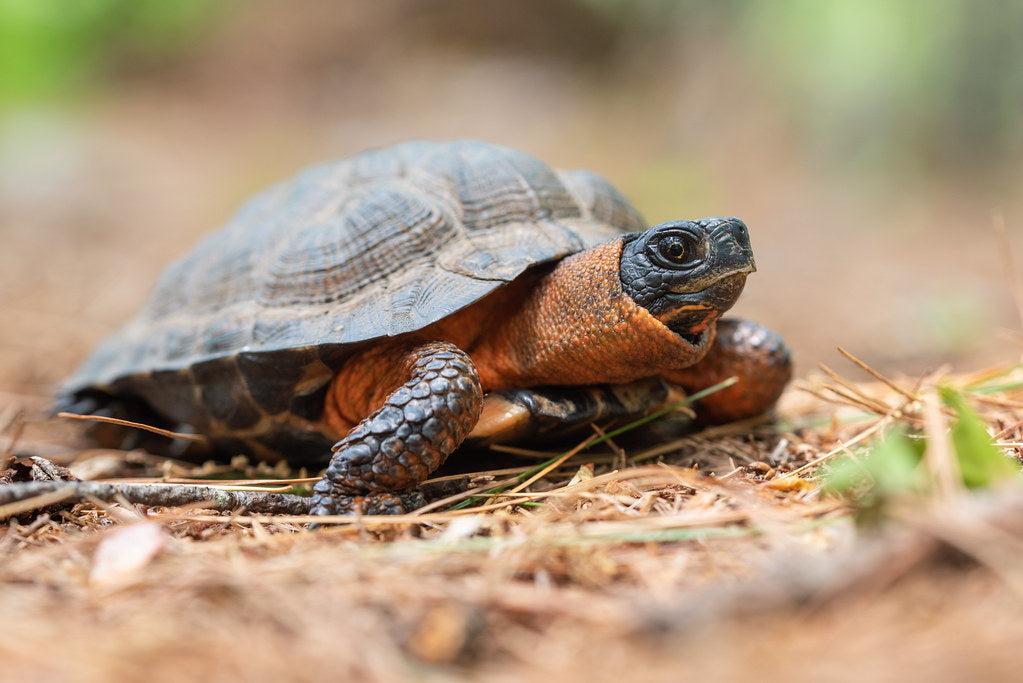Three-toed box turtles (Terrapene carolina triunguis) are small to medium-sized, terrestrial turtles native to the central United States. They generally prefer moist woodlands for habitat, although they can sometimes be found in hardwood swamps. They like having access to plenty of leaf litter and woody debris for cover.
Three-toed box turtles are generally around 5” long, but particularly large females may grow up to 7”. These turtles are tortoise-like in appearance, with a highly domed shell, stumpy legs, and a hinged plastron that allows themselves to retract into a “box” when threatened. They usually have a light brown or olive base color, with yellow or orange scales on the forelimbs. Some males have red heads. True to their name, each of this turtle’s hind limbs usually has only three toes, but cases are known of this species having four toes instead.
Three-toed box turtles are a big commitment, so they’re not a pet that can be brought home on a whim. However, with appropriate care, they can live into their 50s, possibly longer.
Note: Box turtles may be very common in the US, but they aren’t easy pets! If you want a pet box turtle, purchase one from a breeder or adopt one from a rescue or your local classifieds. Never take box turtles from the wild! Furthermore, keep in mind that box turtles are illegal to keep in some parts of the US.
How much space do three-toed box turtles need?
A single three-toed box turtle should have no less than 8 square feet of floor space, and preferably more. Unlike other box turtles, three-toed box turtles are surprisingly adept climbers, so make sure that your enclosure’s walls are sufficiently high and do not have footholds. Because of their humidity requirements, it is best to house them in a fully-enclosed setup rather than an open tortoise table, unless they are being housed outdoors.
Housing your three-toed box turtle outdoors is strongly preferable to keeping them indoors, whenever possible. The walls should be at least 20” tall above ground, and extend at least 10” underground to prevent escape. Build the pen in an area where the turtle will have access to both areas of sun and shade during the day.
Three-toed box turtles are generally considered solitary creatures, and can be kept by themselves just fine. But they are reported to be able to get along in groups as long as the size of the enclosure is increased proportional to the number of turtles being housed.
Do three-toed box turtles need UVB?
Yes. Aside from helping provide a day/night cycle and an infinite supply of vitamin D, UVB is also essential to your turtle’s overall health. The best UVB bulbs for three-toed box turtles are:
- Arcadia T5 HO 12%
- Zoo Med T5 HO Reptisun 10.0
The bulb should be half the length of the enclosure and mounted in a high-quality reflective fixture such as Arcadia or Vivarium Electronics. This fixture should be mounted 17-18” above the top of the turtle’s shell in the basking area, inside the enclosure.
If your box turtle is being housed outside and has access to direct sunlight, artificial UVB lighting is not required.
Since box turtles are diurnal (day-active), it’s a good idea to add a strong 6500K LED or T5 HO fluorescent grow light to further illuminate the enclosure and better simulate daylight.
All lighting should be on for 14 hours/day during summer and 10 hours/day during winter. This simulates natural seasonal cycles and may stimulate healthier hormonal rhythms.
What basking temperatures do three-toed box turtles need?
Three-toed box turtles should have a basking air temperature of around 85°F, with a cool/shaded area on the other side of the enclosure around 70-75°F. Temperatures should be measured with at least two digital probe thermometers, one placed on each side.
Heat your turtle’s enclosure with a 50w halogen heat lamp placed on one side of the enclosure, mounted at roughly the same height as the UVB lamp. If the lamp is too warm, reduce the heat with a plug-in lamp dimmer. If the lamp is too cool, you will need a higher-wattage bulb.
Do not use ceramic heat emitters (CHEs), heat mats, red bulbs, or blue bulbs, as these are not as effective. All heating should be turned off at night.
If you are keeping your box turtle outdoors, make sure air temperatures never exceed 90°F, as these turtles overheat easily. Providing shade and a shallow pool to soak in can help these turtles cope with the occasional hot day. They can tolerate nighttime temps as low as 50°F.
What humidity levels do three-toed box turtles need?
Three-toed box turtles should have an average humidity of 60-80%. As a woodland species, they need consistently high humidity in their environment to stay healthy. Humidity should be measured by a digital probe hygrometer with the probe in the middle of the terrarium.
To help maintain high humidity levels, mist your enclosure 2x/day with a spray bottle and use a thick layer of humidity-retentive substrate with leaf litter. It’s also a good idea to provide a humid hideout lined with moistened substrate or sphagnum moss and placed in the middle to cool end of the enclosure.
As long as you don’t live in a particularly dry climate, humidity shouldn’t be too much of a concern when keeping three-toed box turtles outdoors. Just make sure they have access to a soaking tray, shade, and plenty of lightly moistened leaf litter.
Either way, hatchling and juvenile box turtles should be soaked in a tub of shallow water 1-2x/week for 10-15 minutes per session to ensure adequate hydration and optimal growth.
What substrate is good for three-toed box turtles?
Substrate covers the floor of your enclosure and helps make the setup more attractive, but it also helps maintain higher humidity levels and provides something for your turtle to dig into as desired.
It’s ideal to use a substrate that imitates what three-toed box turtles naturally live on in the wild. In other words, you’ll need something that resembles soil. It should have small particles, hold moisture well, and be loose enough to dig in. Access to a generous layer of leaf litter is essential.
We recommend the following substrates for three-toed box turtles kept indoors:
Substrate should be at least 4” deep to facilitate burrowing behavior, and completely replaced every 3-4 months. Remove poop and urates daily, along with contaminated substrate.
What décor can you use in a three-toed box turtle enclosure?
It’s terribly boring for a reptile to be stuck in an enclosure with nothing in it except substrate and food/water bowls. It doesn’t matter how big the enclosure is if you don’t put things in it for your pet to use and interact with.
Here are some décor ideas that are appropriate for three-toed box turtles:
- piles of leaf litter
- additional hiding places/burrows
- large hollow logs
- live, edible plants/shrubs
- large, flat stones
- substrate mounds/hills
- wood piles
What do three-toed box turtles eat?
Three-toed box turtles are omnivorous, which means that they need both plant and animal matter in their diet. For best health, strive for a balance of roughly 45% plants and 55% low-fat animal protein, with more vegetables than fruit.
Protein sources for three-toed box turtles: cockroaches, earthworms, mealworms, superworms, snails, millipedes, grasshoppers, crickets, moths, hornworms, silkworms, black soldier fly larvae, darkling beetles, pinky mice, quail chicks, wet cat food
Safe vegetables for three-toed box turtles: cactus pads, kale, collard greens, turnip greens, mustard greens, dandelion greens + flowers, watercress, broccoli, escarole, swiss chard, parsley, spinach, endive, romaine lettuce, hibiscus leaves + flowers, nasturtium, honeysuckle
Safe fruits for three-toed box turtles: grapes, blackberries, cherries, strawberries, plums, apples, persimmons, cantaloupe, mulberries, tomatoes
Young and growing box turtles younger than 5 years old should be fed daily to every other day, while box turtles older than 5 years should be fed 2-3x/week. For best results, offer food first thing in the morning.
Supplements
You will also need calcium and vitamin supplements to prevent your turtle from developing a potential deficiency. We recommend Repashy Calcium Plus LoD, lightly dusted on each protein meal. A carotenoid supplement like Repashy SuperPig can be helpful for maintaining your turtle’s vibrant color.
Water
Of course, don’t forget a water bowl for your turtle to drink from! Box turtles like to soak, so it’s best to offer a shallow “puddle” of water for them to soak in and drink from (cat litter trays work well for this). Change the water daily and scrub the bowl with a reptile-safe disinfectant weekly, or whenever it becomes soiled.
Do three-toed box turtles like to be handled?
Few reptiles actually “like” to be held, but three-toed box turtles generally tolerate human interaction well, especially individuals that were bred in captivity. They don’t like to be held, though. Instead, try hand-feeding and gentle petting to bond with your turtle. Many pet box turtles learn to recognize their keepers and will come running for food.
If you have to grab your turtle, avoid grabbing it from above, as that will scare it. Instead, approach from the side and scoop from below.
*This care sheet contains only very basic information. Although it’s a good introduction, please do further research with high-quality sources to obtain additional information on caring for this species.
"Three-Toed Box Turtle (Terrapene carolina triunguis)" by 2ndPeter is licensed under CC BY 2.0




Leave a comment
This site is protected by hCaptcha and the hCaptcha Privacy Policy and Terms of Service apply.